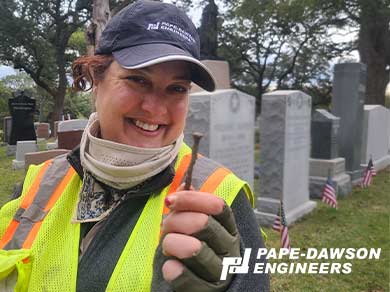For new construction, everyone’s eyes are on the future – how the addition will change the function and look of the landscape.
But one team at Pape-Dawson Engineers keeps a watchful eye on the past to ensure the project site’s history is not lost.
As Pape-Dawson Cultural Resources Program Manager, Dr. Karissa Basse leads her environmental team to explore the sites identified for development. “I get to dig in the dirt and look for old trash,” she laughs, though the “trash” she exposes is evidence of past human occupation, which can be archeological and cultural treasures.
Before construction begins, her team surveys the area to find elements of archeological value. She sees that work as consistent with the culture of San Antonio. “We have a real focus on tourism here, and especially on history and culture,” she says. “There are many significant resources in San Antonio from both before and after the arrival of Europeans in Texas that are important to history and to the community. Part of what we do is help identify those properties.”
Surprises can sometimes upend construction. With its millennia of recorded history and stratified ruins, Rome’s subway effort regularly exhumes work-stopping archeological discoveries. Although San Antonio may lack some of Italy’s extensive cultural resources regulations, it has its share of notable artifacts that can pause construction. That happened, for example, when the San Pedro Creek Culture Park project uncovered the foundation of a historic Black church in 2020. “However, these finds can add value to a project through incorporation into the overall design, and we work with our clients to evaluate the best path forward for a project when an important discovery is made,” Karissa says.
San Antonio is unique in having three levels of regulatory compliance. Across the nation, cities must operate in accordance with federal and state codes. San Antonio is one of the few U.S. cities that have municipal codes, too. Before construction begins, regulations require a three-level process to ensure a project does not destroy items of archeological value.
The first level begins with a preliminary map assessment of the project area. “I wish we had X-ray vision, but we don’t,” says Karissa. “Instead, to start out we’ll look at geology and pre-contact and historical settlement patterns to make an initial judgment.” Natural water sources are a good indicator; locations within proximity to a water source have a high probability of having been a home to Native Americans in the past. Population maps (which date back to 1737) or a historic-age aerial photography from the early 20thcentury can also indicate that a location is likely to contain later archaeological sites.
“There’s art as well as science in that step,” she says. If an initial desktop analysis indicates a site might hold something of interest, shovel work can confirm it. A team digs 30-cm-wide holes, 10 cm deep at a time, precisely recording location and soil color and texture. “We can go 80 to 110cm deep, and sometimes we need to bring a backhoe to go deeper than we can by hand.” Throughout the process, her team takes detailed notes and records data, while screening the dirt for artifacts, such as chipped or burned stone, animal bones, glass, ceramic, or metal. Interrogation at this first level indicates whether a site is free of archeological interest and ready for construction, or if Karissa’s team should progress to the second level.
The second level inspects the evidence for signs of significance and integrity. Significance usually involves a pattern of history or a significant person or event. Integrity means the site has intact pieces. For example, “it’s common to find well-preserved foundations, basements, or wells in downtown San Antonio,” she says. Karissa’s team looks for criteria under local, state, or federal guidelines that may mark the site as one with significance and integrity—or could even warrant its inclusion in the National Register of Historic Places, the City of San Antonio’s list of historic landmarks and historic districts, or designation as a State Antiquities Landmark.
If a project site possesses the significance and integrity to warrant it, final mitigation and data recovery is the third and final step, if the site cannot be preserved and avoided by construction. Precisely how the team conducts its work depends on the regulation that governs the site, but any such work requires an in-depth research design and questions to address. Hand excavation preserves and records the relics that may be hidden in the ground for current and future generations.
Her team’s recent work on a project downtown involved hand excavation at a site inhabited by José Antonio Ruiz, a signer of the Texas Declaration of Independence. “We didn’t find evidence of the house, as it had been moved in 1943, but there were layers showing occupation to the mid-1700s, and prior to that Native American occupation,” Karissa says. “For a project like that, we try to collect or record 100% of the materials, analyzing and weighing bricks, coal, glass, ceramic, and lithic [rock] material.” Her team carefully transports items to the lab, where they painstakingly wash, tag, count, weigh, and catalog each one. The data comprise a “massive analytical inventory,” noting details such as use, technological attributes, morphology, decorations, and other classifications for each artifact.
Thanks to Karissa and her team, the march to the future can continue while preserving crucial links to the past.
